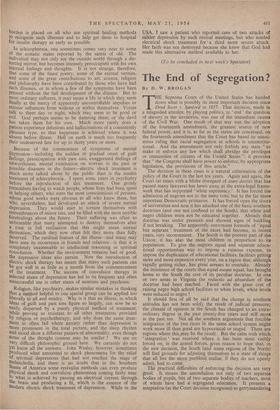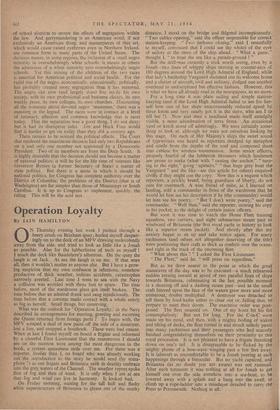The End of Segregation?
By D. W. BROGAN THE Supreme Court of the United States has handed down what is possibly its most important decision since Dred Scott v. Sanford in 1857. That decision, made in a misguided attempt, by playing politics, to ' end ' the question of slavery in the territories, was one of the immediate causes of the Civil War. One result of that war was the adoption of the fourteenth amendment, the greatest source of new federal power, and it is, as far as the states are concerned, on the fourteenth amendment that the Court has based its unani- mous ruling that facial segregation in schools is unconstitu- tional. And the amendment not only forbids any state " to make or enforce any law which shall abridge the privileges or immunities • of citizens of the United States "; it provides that," the Congress shall have power to enforce, by appropriate legislation, the provisions of this article."
The decision in these cases is a natural culmination of the policy of the Court in the last ten years. Again and again, the Court (at times with a blithe disregard of stare decisis that has pained many lawyers) has hewn away at the extra-legal frame- work that has supported ' white supremacy.' It has forced the admission of negroes not to the mere vote, but to the far more important Democratic primaries. It has forced open the doors of universities and now it has attacked one of the basic southern doctrines (and one not confined to the South), that white and negro children must not be educated together. Already that doctrine was under pressure and showed signs of buckling if not breaking. The apparently convenient formula of ' equal but separate' treatment of the races had become, in recent years, very inconvenient. The South is the poorest part of the Union; it has also the most children in proportion to its population. To give the negroes equal and separate educa- tional opportunities was to impose a ruinous expense, to impose the duplication of educational facilities, facilities getting more and more expensive every year, on a region that, although rapidly getting richer, has great arrears to overtake. Already the insistence of the courts that equal meant equal, has brought home to the South the cost of its peculiar doctrine. In one or two areas in Virginia the reductio ad absurdum of the doctrine had been reached. Faced with the great cost of raising negro high school facilities to white levels, white levels were reduced to negro !
It should first of all be said that the change in southern attitudes has not been solely the result of judicial pressure; the climate of opinion in the South has changed to an extra- ordinary degree in the past twenty-five years and still more in the past ten. Not all the southern arguments that forcible integration of the two races in the same school system might work more ill than good are hypocritical or stupid. There are regions where thisjuay be the result. But the calm with which ' integration ' was received where it has been most visibly forced on, in the armed forces, gives reason to hope that, in the new decision, the South (and some regions of the North) will find grounds for adjusting themselves to a state of things that all but the more purblind realise, if they do not openly admit, had to come.
The practical difficulties of enforcing the decision are very great. It means the assimilation not only of two separate bodies of pupils, but of two separate bodies of teachers, most of whom have had a segregated education. It presents a temptation (as the Court decision recognises) to gerrymandering of school districts to secure the effects of segregation within the law. And gerrymandering is an American word, if not exclusively an American thing, and masterpieces of that art, which would cause raised eyebrows even in Northern Ireland, are common form in many parts of the United States. The decision means, in some regions, the inclusion of a r.inall negro minority in overwhelmingly white schools; it means in others the admission of a white minority into overwhelmingly negro schools. Yet this mixing of the children of the two races is essential for American political and social health. For the rapid rise of the negro, economically, educationally, politically, has probably created more segregation than it has removed. The negro can now (and largely does) live ins:de his own society, with its own professional and business classes, its own weekly press, its own colleges, its own churches. Discounting all the nonsense about devoted negro mammies,' there was a meaning in the legend. The races were in 'contact at a level of intimacy, affection and common knowledge that is rarer today. That the separation was a good thing, I do not deny; but it had its disruptive sides. Jim and Huck Finn would find it harder to get on today than they did a century ago.
There remain to be noticed the political effects. The Court that rendered the unanimous decision had only two Republicans on it and only one member not appointed by a Democratic President: Two of its members are from the Deep South. It is highly desirable that the decision should not become a matter of national politics; it will be for the life time of veterans like Governor Byrnes (a former Secretary of State) a matter of state politics. But there is a sense in which it should be national politics, for Congress has complete authority over the District of Columbia; the problems of the District (that is of Washington) are far simpler than those of Mississippi or South Carolina. It is up to Congress to implement, quickly, the ruling. This will be the acid test.



































 Previous page
Previous page